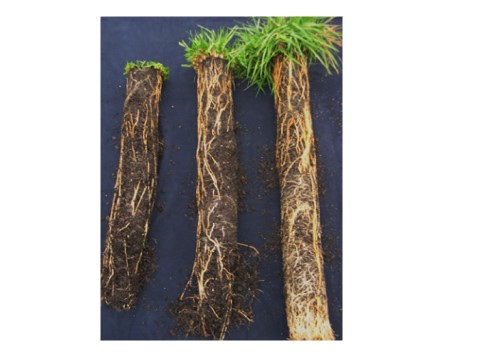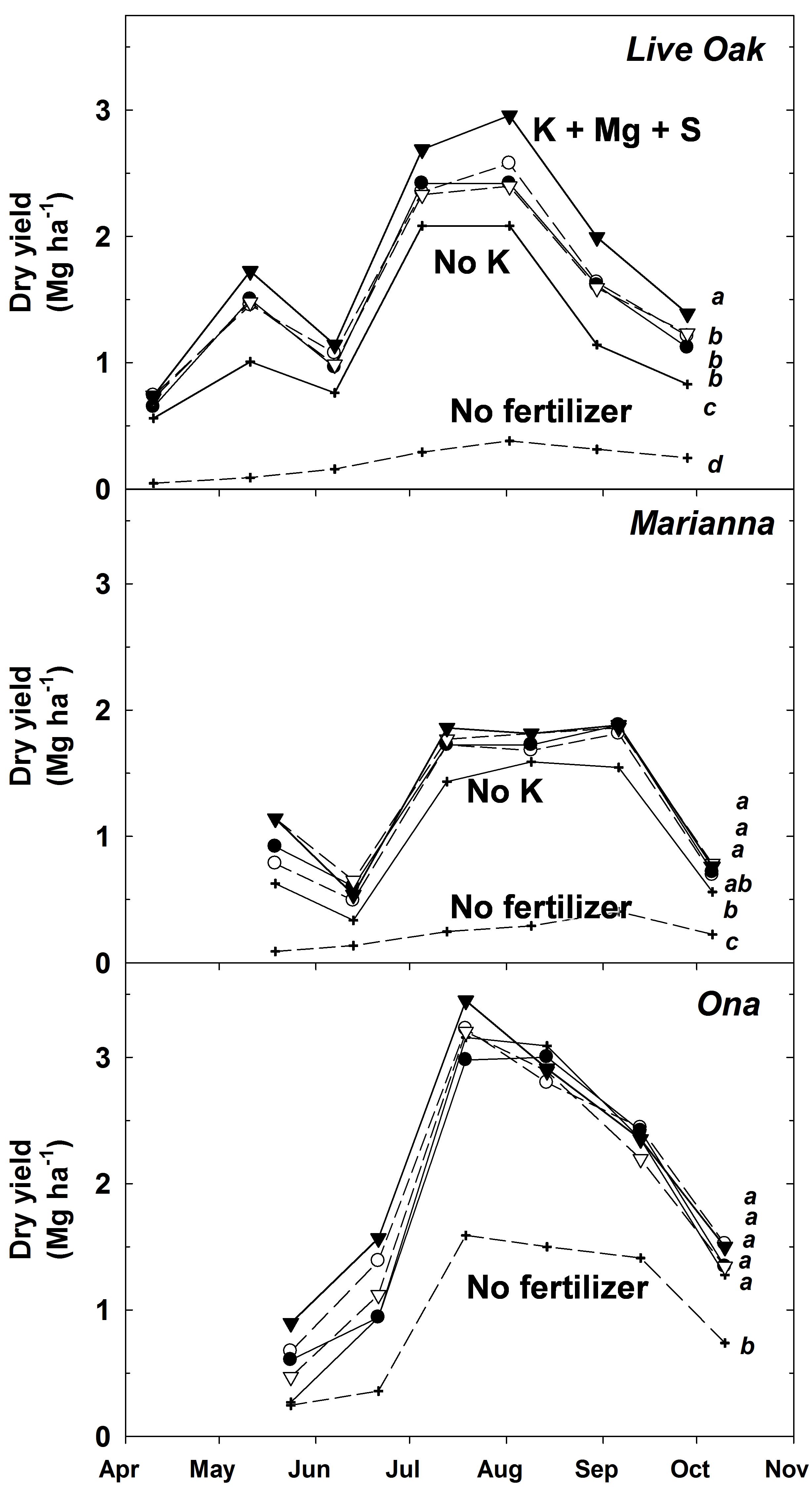Cheryl Mackowiak, Soils Specialist

Fig. 2. Argentine bahiagrass under different management. From left to right: Over-grazing (>80% forage removed weekly), recommended grazing (50% of forage removed weekly), and no grazing (forage not removed).
It is June and we are fast approaching the longest day of the year (June 21st). You may wonder what day length has to do with timing your fertilizer applications. In general, perennial pasture grasses are photoperiod sensitive. In other words, their growth and flowering (seed head formation) respond to day length. This is why you often cannot grow the same amount of grass in March or October as you can mid-summer, even under unseasonably warm temperatures (Figure 1). Can we use this information to better manage our summer pasture fertilization? Perhaps…

Fig. 1. Argentine bahiagrass grown as hay at three Florida locations in 2006 to test Potassium (K) fertilizers. The treatment receiving no nitrogen fertilizer (No fertilizer) also demonstrated a growth response to day length, even though it was comparatively less. Different lower case letters represent treatment differences at each location.
Nitrogen (N) is the fertilizer nutrient required in the largest amount by pasture grasses, and where we often see the largest forage yield gains with increasing application rates (up to a few hundred pounds of N per acre, per season). If more of the season’s N is applied when the grass has the genetic potential to grow more forage (June/July), then we should increase seasonal yield, but it will be concentrated during the height of the growing season. If there is not enough livestock to graze it, or an ability to hay it, then that additional forage growth will be wasted. In those cases, a higher proportion of N fertilizer applied mid-season may not benefit your operation. In fact, in the case of a well-managed bahiagrass pasture (has healthy rhizome/roots), N timing may have little measurable difference in forage yield.
There is some supporting evidence of this found in the works of Dr. W.G. Blue during the 1980s. He speculated the massive rhizome/root structure of a well-maintained bahiagrass pasture can effectively absorb soil N when it is available, whether applied in spring or early summer, and store it for later use, more so than many other perennial summer forage grasses. However, it also needs mention that the potential genetic limit of forage yield from bahiagrass grown under optimal conditions does not match the maximum forage yield of some other improved pasture grasses, such as bermudagrass, limpo grass, or star grass cultivars.
In general, it is often recommended that you make your first fertilizer applications around the time of pasture green-up, which may occur as early as February/ March in south Florida or as late as April for locations further north. A small flush of new root growth also occurs during this period to help deliver emerging shoots the water and essential nutrients they need to begin the new season’s growth. As the spring green-up proceeds, the grass will begin replacing that borrowed energy taken from the rhizomes via photosynthesis.
A well-managed bahiagrass pasture will have a massive amount of rhizomatous storage capacity. However, if you have low energy reserves in your roots/rhizomes because of a history of poor soil fertility and/or over-grazing, your grass will suffer from it the following growing season (Figure 2). Weak plants are much more susceptible to pests, diseases, and weed encroachment. They also cannot as easily escape brief periods of drought or low fertility by growing more and deeper roots to better mine soil resources.
Management Considerations and Recommendations:
Follow the soil fertilization recommendations given for pastures in your area, and in particular, recommendations given in your soil fertility report. For example, University of Florida IFAS has published recommendations for bahiagrass pastures and management scenarios that cover low, medium, and high degrees of management/inputs, as well as grazing mixed with periodic hay removal. Please refer to the following publication for additional information: UF/IFAS Standardized Fertilization Recommendations for Agronomic Crops
Your local county extension office have staff and contacts who can help you interpret your soil report (once you sample your soils!) and provide general fertilizer rate recommendations that were developed for your region. Keep in mind that haying actually exports, from the field, relatively large amounts of fertilizer (often 2% of nitrogen and potash and 0.3% phosphate) per pound of dry hay (0% moisture), while grazing recycles most of the plant nutrients via excreta (urine and manure).
Questions are often raised on whether to adjust fertilizer application timing in regards to wet versus dry periods. Commercial, soluble, mineral fertilizers are supplied as salts and these salts need to dissolve in water in order to release the nutrients in a form the plant roots can take up. Even organic fertilizer sources will first mineralize the nutrients into inorganic forms that the plant can take up. The soil microorganisms needed for mineralization also require water. If you foliar apply fertilizer, the plant still needs water to carry out its physiological processes with the applied nutrients. As a general rule, it is often better to wait until you have sufficient soil moisture to support plant growth prior to fertilizing. If you are applying fertilizers other than nitrogen, you will not lose your fertilizer during a dry period. Urea nitrogen, however, can volatilize if left on the soil surface, thereby losing fertilizer value. Do not forget that exceedingly high nitrate accumulation in pasture plants is more likely to occur when nitrogen fertilizer is applied during periods of plant stress, such as water stress.
The biggest concern when applying fertilizers during exceedingly wet periods is the chance for nutrient losses through run-off or leaching. This is particularly true with nitrogen, but also potassium, sulfur, and sometimes even phosphorus can be washed or leached away from the plant. Lost fertilizer is bad for both the producer and the environment.
Summary:
If my pasture is weak because I have continually over-grazed (did not allow recovery periods), then I will likely gain much more yield this season by changing my grazing practices (permanent or temporary cross-fencing) than I will by increasing fertilizer applications or changing application timing. If my pasture is weak because I applied only nitrogen (no other nutrients) year after year, then my best course of action is to soil and tissue sample to assess and address potential soil fertility imbalances. A soil and forage tissue test often costs less than $20 apiece, while thousands of dollars can be lost each season by applying what is not required or through lost revenues via livestock gains or additional pasture treatments (herbicides, etc.). Considering the many environmental factors affecting perennial pastures, and adopting research-based recommendations and management will keep you in the green!
- Grower Survey Insights on Cotton Nitrogen Management in Florida’s Panhandle - July 18, 2025
- Florida Soils are an Indispensable Natural Resource - January 10, 2025
- Regenerative Agriculture: What it Means to You - June 21, 2024
